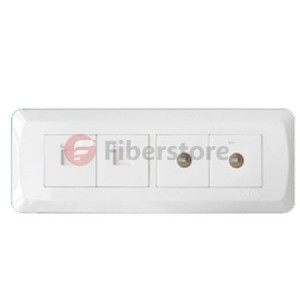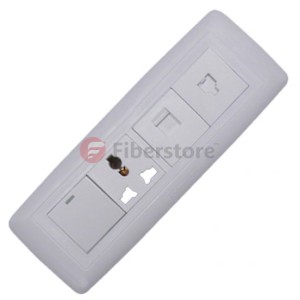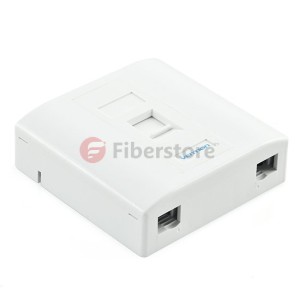Although FTTx is now being widely applied, many places are not able to use optical fiber or FTTx. For example, CAT6 or CAT5e cables are still occupying a certain proportion comparing with fiber optic cables. In some places FTTx and CAT5e/CAT6 network cables are being operated at the same time. In the mentioned situations, network face plates should be taken into consideration during cabling.
Network Face Plate is usually a plastic plate with one or more ports, which allows copper network cables to run between rooms beneath floors and behind walls. It is important to choose appropriate network face plates or wall plates during cabling.
Before you install network face plates, you should know which ones satisfy your needs most. The face plates you choose should conform to the standard you have chosen for your overall system. A good choice of network face plates or wall plates will not only help to maintain the quality of your infrastructure, but also save valuable spaces and cost. How to select the appropriate network face plates and wall plates? The following will give you the answer.
First, you should make sure how many types of cables you need to run. Usually, people need multiple medium to maintain communication. For example, telephone, Internet and TV are always the “must-have” medium during home network cabling. They should be connected with different network face plates. You might need several network face plates separately with RJ45 port, RJ11 port and TV port. However, in many situations, those cables come into home from one location. Then, it could be really bothering to install these face plates one by one. In addition, it’s not space saving and the appearance is not nice. Luckily, you can find that many manufacturers are providing network face plates with multiple ports in one to meet your specific networking needs. For example, except the network face plate with one port, Fiberstore also provides many other network face plates like the followings:
- Face plate with one or more RJ45 port(s) and one or more TV port(s)
- Face plate with a RJ45 port, RJ11 port and a TV port
- Face plate with a RJ45 port, a RJ11 port, as well as an electrical socket and switch.


The above picture on the left shows a network face plate with two RJ45 ports and two TV ports. The above picture on the right shows a network face plate with one RJ45 port, one RJ11 port, one electrical socket and one switch.
Fiberstore could even provide RJ45 wall plate with a RJ45 port and a SC port for the situations in which both copper cable and fiber optic cable are being used.

The above picture shows a RJ45 wall jack with a RJ45 port and a SC port.
The size of the network face plate is another thing should be considered during cabling. There are generally 3 types of standard network face plates. They are known as 86 type, 118 type and 120 type network face plates. 86 type network face plate is square, with a size of 86*86mm, with one to three ports. 118 type network face plate is a rectangle network face plate generally with a 118*72mm size or other sizes. 120 type network face plate usually has a size of 120*120mm, 120*60mm or other accordingly.
One more thing cannot be ignored during network cabling is the cable type. The most commonly used copper network cables are CAT5e or CAT6. It is essential to make sure whether the network face plates are suitable for the cables you chose.
By taking the mentioned aspects into consideration, you are sure to find the right network face plates for your needs.
Fiberstore supplies a variety of network face plates, such as AMP Face Plate BS Shuttered, 86 type network face plates, 118 type network face plates. These face plates are available with 1 port, 2 ports, 4 ports, etc. Our high quality network face plates are compliant with international standards with low price and worldwide delivery. They can help you save time & money for your business or project.
